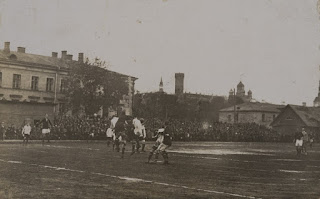It doesn't look like very much nowadays, but this little football ground is one of the most historic in Estonian football and it should have a little place in the hearts of every local football fan worth their salt. This is Wismari staadion, the oldest football ground in continuous use in Tallinn and in perhaps all of Estonia.
The Wismari staadion was originally built in 1916 at the back of what was originally a German poor school, the Toomvaestekool, which itself was constructed in 1867 and has its own rather interesting history, having been used as an Estonian primary school from 1917 until the outbreak of the Second World War, and later as an industrial school, an Oncology dispensary, the Tallinn Republican dispensary and, since 1985, a five-bed psychatric hospital dealing in alcohol and drug addiction. It is even a listed building (no. 1250) in the Estonian National Register of Cultural Monuments.
The Wismari staadion with the former Toomvaestekool to the right of the pitch, behind the dressing-rooms
The Toomvaestekool owned a piece of land immediately behind it, and it was rented out to local sports club Tallinna VS Sport in 1916, a gymnastics and sports club founded in June 1912, who built dressing-rooms, an athletics track and a wooden toboggan hill, which was used in winter along with a skating-rink. Both were dismantled a few years later and replaced by a football pitch. In winter, bandy and ice-hockey were played there.
The Wismari staadion was used only once for an international match, when Estonia took on Finland on 30 September 1923. According to records, the game was moved from the Kalevi Aed staadion (now home to the Viru Keskus shopping-centre) because the pitch at the latter was apparently "too muddy."
ESS Kalev : Kaiserwald (Latvia) at the Wismari Staadion, October 1922 (Photo: Karl Hugo Akel; held in the archive of the Eesti Sporti- ja Olümpiamuuseum)
Four thousand people crammed into the Wismari staadion to see Estonia win the match by two goals to one. Vladimir Tell put the home side in front just after the hour mark, but Torsten Österlund soon levelled for Finland. However, Ernst Aleksandr Joll scored the winner for Estonia with six minutes left.
In 1932, the Wiismari staadion was apparently taken over by Eesti Spordi Selts Kalev - which modern-day Tallinna Kalev claims as its mother club - and Tallinna Velodroom, with a 250 metre-long track, which was regarded as the best in the Baltic countries at the time, was opened on 15 May of that year. After only a few years, however, it, too, was dismantled.
The deciding match in the 1924 Estonian championship final series: Tallinna Sport 2:0 ESS Kalev, 2 November 1924 (Photo: unknown; held in the archive of the Eesti Sport- ja Olümpiamuuseum)
Most of those Estonian clubs which survived until the early 1940s were disbanded when first the Soviet Union and then Germany invaded and took over the country. Others, such as Dynamo Tallinn, were founded at around that time, and went on to win a plethora of titles in what became the Estonian SSR first division, using the Wismari staadion as their home base for a number of years in the 1950s and 60s.
In recent years, the ground was being used less and less frequently and had fallen into a state of disrepair. Finally, in 2007, the Estonian FA took action and renovated the ground, replacing the artificial pitch seven years later.
Alongside an indoor training facility, the ground is currently being used by Esiliiga (third level) side Tallinna JK Legion as a training ground for their first team and the home ground for the club's reserve and junior teams.
Sadly, the Wismari Staadion is once again looking rather run-down and in a state of disrepair, and tenants Tallinna Legion have been finding it increasingly difficult to make ends meet, let alone find the money to do some much-needed repairs to the ground, which is owned by the Estonian FA, and now find themselves in the third level of the national football pyramid after two relegations in a row.
The Wismari staadion is a very small ground which will most probably never again be one of Estonian football's premier stadia, but it does deserve some care and attention and it certainly should have a role to play in the future of football in the country, especially when one considers the role it has played in its past. The average historically-minded groundhopper could do worse than put the Wismari Staadion on their bucket-list
AUTHOR'S NOTE: Much of the information contained in the above article was taken from the Estonian FA website, Wikipedia and archive issues of Eesti Spordileht (via www.digar.ee).
Photos are author's own unless otherwise stated. Link to Karl Hugo Akel's photo:
https://www.muis.ee/et/museaalview/3222246
Many thanks to the Tallinna Kesklinna Valitsus for their assistance.













No comments:
Post a Comment